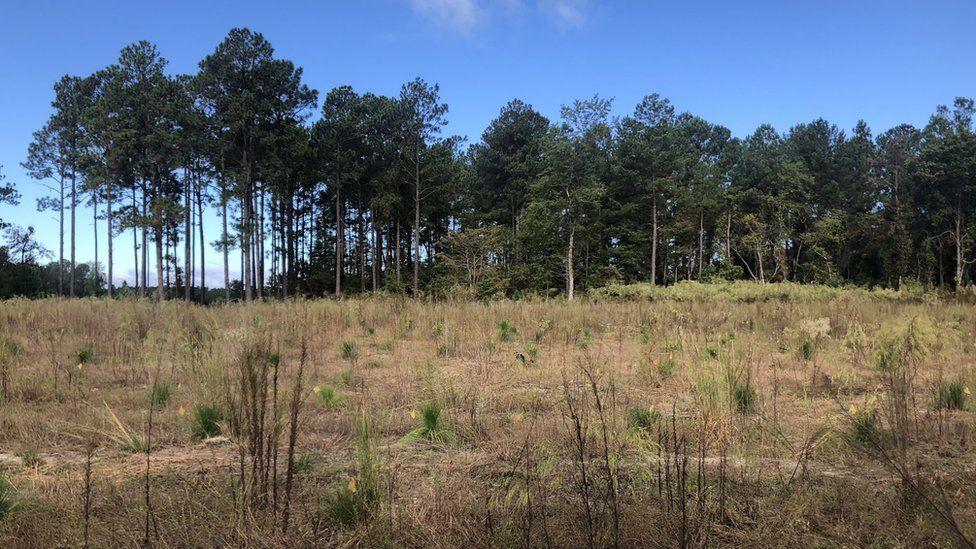Africa-Press – Eritrea. The areas in and around North Carolina’s forests feel spacious. Canopies of lanky pine trees eventually give way to enormous car parks and long-term storage units, underscoring the feeling of vastness.
Many of these US trees are destined to be turned into small pellets for the biomass industry. At wood pellet mills, wood is chipped, dried, ground and compressed into uniform, easily storable pellets. They’re then shipped mainly to the UK, where they’re burned for energy.
Most forest land in North Carolina is privately owned, in holdings that can be as small as one acre (0.4ha). This can mean they are too small to qualify for conservation easements – agreements encouraging landowners to keep trees intact, sometimes with tax benefits.
Small forest owners here include a number of third-generation African Americans whose ancestors moved north and west as part of the Great Migration (the movement of six million African Americans between 1916-70 out of the rural southern US to the urban Northeast, Midwest and West) leaving the cropland to turn back into forest.
“A lot of minority landowners are really disconnected from their land,” says Freddie Davis III, a forester who leads the Rural Training and Research Center, which is part of the Federation of Southern Cooperatives.
Mr Davis believes that biomass is the best option on such low-value holdings for these owners – who typically live away from their forest land and often not even in the same state. “I’m super passionate about it because it offers opportunity,” he says.
Yet the racial justice aspect is complex. Sherri White-Williamson, who leads environmental justice policy for the North Carolina Conservation Network, works out of a cramped office in Clinton. The area has a large black population and is about 20 minutes away from a pellet mill. “We’ve pretty much become the dumping ground for a lot of things for the sake of economic development,” she says.
While the wood pellet industry is an important local employer, Ms White-Williamson argues that the effects on water, air and noise mean that these companies aren’t the best of neighbours.
Volatile organic compounds from wood pellet manufacture, especially softwood like pine, are a problem because of the way they’re converted into formaldehyde and other noxious substances, says Derb S Carter Junior, a lawyer at the Southern Environmental Law Center.
Enviva, the world’s main producer of wood pellets, counters that its plants are in compliance with air quality regulations.
Biomass is controversial, not just locally for the affects on communities near pellet plants, but also globally for the unusual way that its carbon emissions are counted. Many argue that the current carbon accounting rules on wood pellets are not fit for purpose.
They are accounted at the harvest site, such as in North Carolina, rather than the place where they are actually burnt, notably at the UK’s Drax power station in Yorkshire.
The reason for this is that because the trees are replanted, this form of energy is renewable. Decades ago, the Intergovernmental Panel on Climate Change (IPCC) agreed under the Kyoto Protocol that it would be simpler to account for the carbon emissions of land use only when harvested.
But these decisions have been not just scientific but political, says Peg Putt, who coordinates biomass campaigns for the Environmental Paper Network: The negotiators mainly “come out of the forest agencies of the various countries, have close ties to industry and work to advantage the interests of the forest industry,” she argues.
“They have made the accounting seem so forbiddingly complicated and technical that higher level negotiators in the party delegations just leave it to them.”
Lawyer Derb Carter says the US now has a “proliferation” of wood pellet mills “where – they’re all for export, mostly to Europe – and essentially no utilisation of this material here in the US for energy production”.
In 2018-19, all of the wood pellets fed into the UK’s Drax power station were imported. Mr Carter says for the EU, UK, and increasingly Japan and South Korea, this system is “almost a free ticket in some ways”.
The emissions from burning wood don’t actually show up in these countries’ emissions records, because of what he says are the “perverse accounting” rules on wood pellets’ carbon emissions.
A growing number of scientists and policymakers understand that biomass is not an instantaneously carbon-neutral source of renewable energy. Mr Carter says it is a “simplistic notion” that trees are a renewable resource. Trees cut for biomass can take 30-100 years to fully grow back. Even if they store some carbon as they grow – the maximum amount of carbon dioxide is only absorbed by fully mature trees.
Drax defends it use of wood chips to make electricity.
“Biomass is a reliable, flexible renewable power source which is available regardless of what the weather does. It therefore has a vital role to play in the energy system, displacing coal and supporting the grid to further decarbonise, by enabling more renewables like wind and solar to come online,” a spokesperson said.
Wood pellet producer Enviva points out it is not sourcing from pristine forests, but managed forests which need to be thinned periodically to maintain good health, yet whose wood quality isn’t high enough for higher-value markets like paper.
According to Enviva, its wood pellet mix is made up of 20% sawmill residues, 14% thinning, and the remainder from harvest.
Kim Cesafsky, Enviva’s director of sustainability, is adamant that “we directly displace coal”. She calls fossil fuels “a one-way street”, in contrast to biomass.
Yet biomass is actually even more polluting than coal. “Burning wood for energy produces at least as much carbon dioxide as burning coal per unit of energy produced and usually more,” Ms Putt explains.
Wood is less energy dense than coal, so “you have to put more into burning it to get the amount of energy that you want – therefore you release, generally, more carbon dioxide,” she says.
Prof Gert-Jan Nabuurs, who researches forestry at Wageningen University, the Netherlands, is one of the coordinating lead authors of the Intergovernmental Panel on Climate Change (IPCC). He acknowledges that wood does not burn as efficiently as natural gas or coal “and that is why for the same amount of energy, you are emitting more”. But he argues that “this biomass for bioenergy is a short cycle” as the trees are replanted.
Yet this idea runs contrary to proforestation – the principle of keeping forests intact – because as diverse forests are replaced with plantations of a single tree species, this makes them not only more vulnerable to disease but also generally less efficient at sequestering carbon.
According to Ms Putt: “Plantations are less carbon dense than are natural forests, generally speaking, and they get logged more frequently. So they have less opportunities to sequester carbon.”
The second story on wood pellets in this series will cover how power stations are using biomass to generate electricity and will be published on Friday 14th January.
For More News And Analysis About Eritrea Follow Africa-Press







